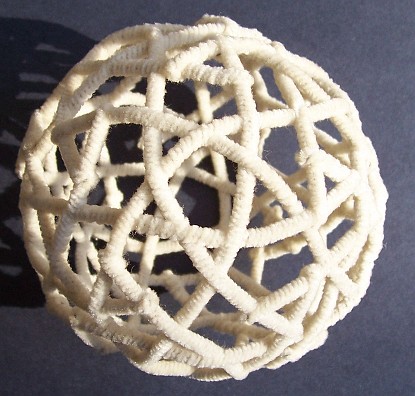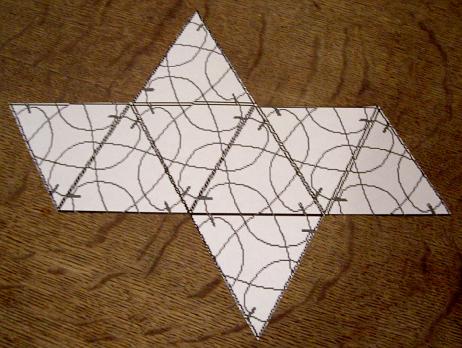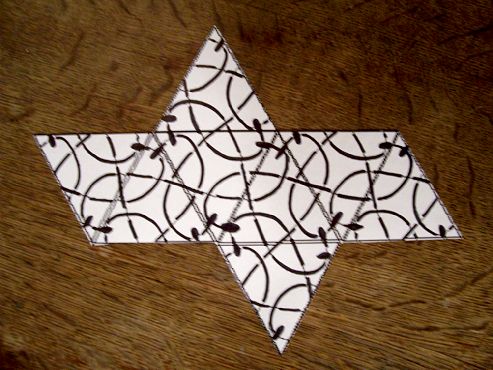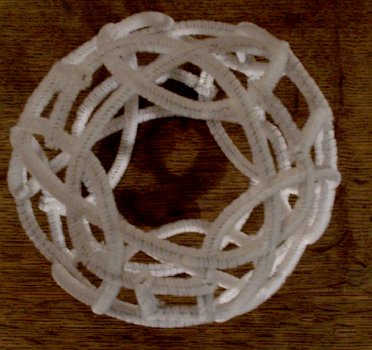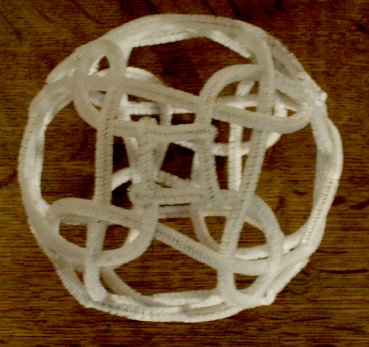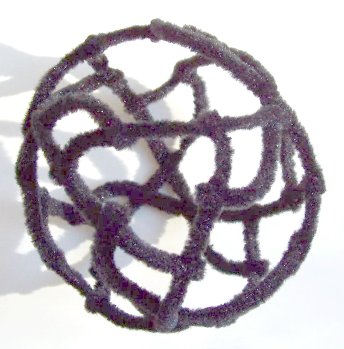Whatever you draw will be replicated with 3-fold symmetry in each
triangle. Note that the midpoint of each triangle edge will be a 2-fold
symmetry point, such as the green dot in the above image. Start at any
2-fold point and draw a curve which isn't too complex, such as the
heavy red line above, ending it with a short backtrack to indicate a
folded end of the pipe cleaner. It will be replicated with the
symmetry to make all the other copies. (On your screen there will be no
green dot and the original line will not be heavier than the others. I
modified this image for clarity.)
First try to replicate the above design, to learn how the program
works, but then make your own design. A good design will not have any
places where three or more lines cross simultaneously. You don't want
your first project to be too complex, so don't let the line be too long
or cross too many other lines. The line you draw from a 2-fold point to
the end represents half a worm. The complete worm, from end to end, is
symmetric like a propeller and has the 2-fold point at its center. Here
are some other examples of reasonable complexity for a first time
project:
example 2 example
3 example 4. These all have smooth
curves, but sharp angles and zig-zags are OK also.
2) Make a paper net for an octahedron
from eight triangles. To print out the pattern, first copy the
screen to the clipboard by using the
PrintScrn
key. Then paste the screenshot from the clipboard into any paint
program. Crop down the image to include just enough triangles to make
an octahedron net. Save it to an image file and print it out. Cut out
the paper net, which for the above example looks like this:
3) Use a marker to emphasize an
over-and-under pattern on the paper. A good weaving pattern will
respect the symmetry. Every triangle should have the same pattern
and within each triangle
the same one-third-of-a-triangle repeats three times. Draw the end as a
heavy blob regardless of whether it would otherwise cross as an over or
an under. There will be two
overs or two unders in a row at the crossings closest to the 2-fold
axis. This is a necessary consequence of the fact that it is a symmetry
point. Here is a marked example:
(Ignore this fine point on first reading: Optionally, you
may be able to maintain over/under alternation along the entire length
of the worm if four of the eight triangles have one pattern and the
other four have the opposite pattern (with over/under reversed) and
each triangle is surrounded by three triangles of the opposite type.
But this may be trickier to assemble.)
4) Fold the pattern up to form an
octahedron. A bit of tape will hold it together sufficiently.
The triangle
vertices, which are 6-fold rotation points in the 2D tessellation,
become 4-fold rotation points in the octahedron.
5) Build a spherical version from pipe
cleaners. An octahedron has 12 edges, so you need 12 worms. If
the design is not too complex, you may prefer to cut the pipe cleaners
in half and use a half of a pipe cleaner for each worm. The sequence of
weaving operations is up to you and will depend on your design. It can
be frustrating to keep track of the parts when it is only partially
assembled, but follow the paper
model systematically and be patient. I find it easiest to first fold
the ends of each pipe cleaner back about a quarter inch from each end
before weaving into the structure. Then squeeze the end tight after it
is hooked over the place it is supposed to join. When the weaving is
done, even up the spacings, smooth out irregular curves, round it out
to a sphere, and make it as symmetrical as possible. Here is a wormball
from the above pattern:
6) Observe the symmetry.
Be sure to notice the eight 3-fold points, the six 4-fold points, and
the twelve 2-fold points. Below is the same wormball, as seen along a
4-fold axis:
Part
II. Octahedral Symmetry, 24 worms each not constrained by
symmetry
The steps above are easily modified so you do not start at (or even
pass through) a 2-fold point. In this case, twenty-four worms are
required for octahedral symmetry. The two ends of the worm will be
distinct, so think of them as ends A and B, perhaps marking them on
your printout with two different colors. To mark the overs and unders
of the weave, always start at end A and follow the same alternating
pattern as you work towards B. During assembly you need to be conscious
of whether you are holding end A or end B of any given worm. Below is a
sample pattern to illustrate the symmetry, but make your own. It will
be the only one in the universe of whatever it is!
Part
III. Variations you might try
A) Symmetric colorings. The twelve midpoints of the octahedron's
edges can be seen as the vertices of three squares.With three
colors of pipe cleaners you can make four worms of each color in a
symmetric manner.
B) Symmetry with mirrors. The above patterns are
chiral---they come in left-hand and
right-hand forms. If you use the
*632
symmetry in Kali, you get mirrors as well. Design and build a symmetric
wormball. Below is a sample pattern to illustrate the symmetry:
(Fine point to ignore at first: Although the pattern of lines in
the plane will be exactly mirror
symmetric, the over/under weaving will have to depart slightly from
this: Where a worm crosses a mirror at an angle, it and its reflection
cross, but in the physical construction only one can be the over and
the other must be the under. You can still maintain the rotational
symmetry at the mirror crossings in the over/under pattern you choose,
unless the worm crosses the mirror at a 2-fold axis point.)
C) Icosahedral symmetry
requires more components (30 or 60) so
takes more time, but is more interesting visually because you get
5-fold features at the triangle vertices. There will be 30 worms if
each is 2-fold constrained
and centered on a 2-fold axis, or 60 worms if each is
unconstrained. The figure at the top of this page is a 30 worm
icosahedral construction (which I made about 25 years ago) with the
following pattern:
D) Tetrahedral symmetry
may seem simpler because it involves fewer worms (6 or 12) but it may
be more confusing to build because
there are two different types of places with 3-fold symmetry---one type
corresponds to the tetrahedral vertices and the other type corresponds
to the tetrahedron's faces' centers. And there is much more curvature,
so everything closes on itself very quickly. Here is a 12-worm
tetrahedral construction:
And here is the pattern for it. Notice that the curve does not go
through a 2-fold axis, the two ends are different, and twelve pieces
are required instead of six.
E) "Pyrite" symmetry (which has
the rotations of a tetrahedron and only three mirror planes) can be
done in this technique if you make 4 "left-handed" and 4 "right-handed"
triangles which assemble as an octahedron. (Each triangle abuts three
triangles of the other handedness.) This is most easily accomplished in
a tessellation program by choosing the "3*3" symmetry group. Below is
an example of a layout illustrating this symmetry: (I drew the worm to
touch
the triangle edge midpoints, but that is not essential and it is
not a 2-fold axis point.)
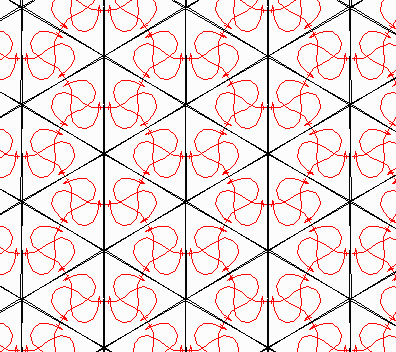
F) n orbits of worms. You can draw n disconnected lines in your
tessellation and build with n
shapes of worms, perhaps using a different color for each type.
Everything above is a special case of n=1.
